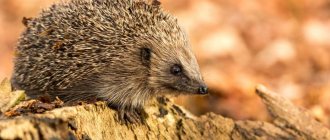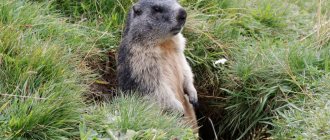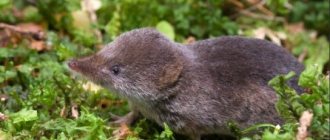- Wild animals
- >>
- Mammals
The long-eared hedgehog is an insectivorous animal that lives in deserts, fields, and steppes. This species belongs to the same family as ordinary hedgehogs, but their body structure and habits are slightly different from ordinary hedgehogs. Eared hedgehogs, unlike other representatives of this family, have rather long ears that are slightly bent forward. The needles of eared hedgehogs also have yellowish spots. Eared hedgehogs are smaller in size than normal ones, and they run faster.
Origin of the species and description
Photo: Long-eared hedgehog
Hemiechinus auritus long-eared hedgehog is a mammal belonging to the order of insectivores, the hedgehog family. There is one species in the genus - the long-eared hedgehog. The hedgehog family is one of the oldest families on our planet. The first representatives of this family inhabited our planet almost 58 million years ago. Fossil urchins found in North America are 52 million years old. The body size of the hedgehog's ancestor was only 5 centimeters. Ancient hedgehogs were similar to modern representatives of this family, but differed slightly in body structure.
Video: Eared hedgehog
The species Hemiechinus auritus was first described by the German traveler and naturalist Samuel Georg Gottlieb Gmelin in 1770. Eared hedgehogs differ from ordinary hedgehogs in the size of their ears. If other representatives of this family have small ears and are practically hidden between the needles, then the long-eared hedgehogs have ears about 6 cm long. The hedgehog's back is completely covered with sharp needles.
Eared hedgehogs are sometimes also called pygmy hedgehogs, due to the fact that they are much smaller than ordinary hedgehogs. The body length of adult males is from 13 to 26 cm, weight from 200 to 470 grams. The shape of the muzzle is sharp. A strip of bare skin is visible in the forehead area; it runs down the body. The hair is soft gray. The coloring of hedgehogs of this species can vary depending on the habitat of the animal.
Taxonomy
The long-eared hedgehog is recognized as an independent species within the genus of the same name (Hemiechinus), which it forms together with the collared hedgehog (H. collaris).
Within the species there are five subspecies:
- Hemiechinus auritus albulus
- Hemiechinus auritus auritus
- Hemiechinus auritus megalotis
- Hemiechinus auritus aegyptius
- Hemiechinus auritus libycus
Appearance and features
Photo: What a long-eared hedgehog looks like
Eared hedgehogs are small insectivores. The body of an adult hedgehog is from 12 to 26 cm in length. The tail size is 16-23 mm, the Pakistani subspecies of animals of this species are larger and are 30 cm in length. Males weigh up to 450 grams, females can weigh from 220 to 500 grams. The spiny shell of eared hedgehogs is smaller than that of common hedgehogs. There is soft hair on the lower sides, muzzle and belly. There is hair on the back and sides with needles pointed at the ends.
The needles are short, 17 to 20 mm long, and covered with small grooves and ridges. Small hedgehogs are born with very soft and transparent needles, and are blind. By the age of 2 weeks, hedgehogs begin to see, learn to curl up into a ball, and their needles become stronger and sharper. Depending on the habitat of the animal, the color of the needles can vary from light straw to black.
The muzzle is pointed. The eyes are small and round. The iris of the eyes is dark in color. The ears are large, up to 5 cm in length, the ears are slightly curved towards the face. The mustache is straight. The strong cheekbones of the animal are strongly highlighted. The mouth has 36 rather sharp teeth. The limbs are long and strong. A hedgehog can run fast, and in case of danger, it curls up into a ball with its needles pointing up. The lifespan of hedgehogs in the wild is about 3 years. In captivity, hedgehogs live longer, up to 6 years, this is due to better environmental conditions and a calm lifestyle.
Eared Hedgehog in the Red Book
Due to a sharp decline in numbers in its usual habitats, the animal required protective status, and it was listed in the Red Book of the Russian Federation and some regions.
Main causes of extinction
In the second half of the twentieth century, the number of a fairly common mammal began to decline sharply. The reason for this was:
- intensive human development of key habitats;
- carrying out economic activities, land reclamation measures;
- the use of pesticides, including spraying from aircraft;
- seasonal fires;
- construction of expressways.
Uncontrolled catching of animals for sale into private hands also had a negative impact on the livestock.
Important! You should not catch a long-eared hedgehog in the wild and bring it home. An adult animal does not adapt well to captivity. It becomes very nervous and may refuse to eat, which will lead to its death.
Current population situation
Sometimes it is not possible to find out the exact reason for the decline and complete disappearance of this animal. Employees of the Rostovsky Nature Reserve conduct annual monitoring of the local population. It is believed that this species is being replaced by more adapted species, the common hedgehog and the white-breasted hedgehog.
In many regions the situation is beginning to stabilize. Today it can be regarded as being of least concern.
What measures were taken to protect
To preserve and increase the livestock, the following measures were used:
- reduction in economic activity in areas of distribution;
- stopping uncontrolled grazing of livestock;
- allocation of special places for pastures;
- compliance with fire safety.
Keeping these animals in zoos and raising awareness also helps restore the population.
Where does the eared hedgehog live?
Photo: Long-eared hedgehog in the desert
The habitat of eared hedgehogs is wide and varied. These animals can be found in the steppes and semi-deserts of Libya, Egypt, Israel, Asia Minor, Pakistan and Afghanistan. They also live in India, the deserts of Kazakhstan and the Mongolian steppes. In China, this type of hedgehog can only be found in the Xinjiang Uyghur region. In our country, eared hedgehogs are found in the steppes of the Volga region and in Novosibirsk. In the Urals from the extreme south of western Siberia to the Altai mountains. Sometimes found on the territory of Ukraine.
Hedgehogs settle in places with dry sandy soil and loam. They choose dry places such as dry valleys, rivers, ravines. They live in deserts with both tall grass and poor vegetation. Does not like places with burnt grass and tall thickets of dead wood. If necessary, hedgehogs sometimes climb mountains to heights of up to 2400 meters above sea level. To live, the hedgehog digs a deep hole up to one meter in length. The hole is closed from the outside. Sometimes eared hedgehogs occupy abandoned burrows of other animals.
Long-eared hedgehogs spend the entire winter in their burrow; by autumn, they insulate their home by dragging leaves into it, arrange some kind of nest, and during the winter they close the entrance to the burrow and hibernate until spring. If it lives near populated areas, settle near the dwelling of a person whom you are not at all afraid of.
Spread of the long-eared hedgehog
The habitat of the long-eared hedgehog includes dry steppes, semi-deserts and deserts.
It inhabits the territory of Israel, Libya, Egypt, Asia Minor, the Caucasus and Transcaucasia, Iran, Iraq, Pakistan, Afghanistan, India, Central Asia, Kazakhstan, China and Mongolia. In Russia, the long-eared hedgehog is distributed from the Don and Volga region to the Ob. A small population lives in Ukraine, where the animal can be found alone in the southeast of the country. The favorite habitats of the long-eared hedgehog are dry, clayey and sandy lands. In modern environmental conditions, for example, due to the continuous plowing of the steppes, the range of this steppe inhabitant is noticeably reduced.
Male and female long-eared hedgehog: main differences
For the long-eared hedgehog, sexual dimorphism is not expressed; the male and female do not have noticeable external differences.
What does the long-eared hedgehog eat?
Photo: Steppe long-eared hedgehog
Eared hedgehogs are insectivores. The diet of eared hedgehogs includes:
- small beetles;
- ants;
- lizards;
- frogs;
- snakes;
- earthworms;
- mice and rats;
- small birds and their chicks;
- bird eggs.
From plant foods, hedgehogs love to eat fruits, berries and seeds of various plants. The long-eared hedgehog can run very fast while getting food; these hedgehogs move much faster than other representatives of this family. So it is very difficult for a hedgehog’s prey to escape the pursuit of this small predator. In addition, long-eared hedgehogs are very hardy; they can live without food or water for up to 10 weeks while hibernating.
Interesting fact: If an eared hedgehog eats a poisonous animal, it not only does not get poisoned, but also develops a stable immunity to the bites of these animals. For example, if a hedgehog has eaten a poisonous viper, nothing will happen to it, and in the future it will not be afraid of bites from these dangerous snakes.
Hedgehogs are considered real forest orderlies; they eat harmful insects, rodents that carry various diseases, poisonous snakes and insects. Therefore, if hedgehogs settle near a person’s home, people begin to feed them, knowing that if a hedgehog lives in a garden plot, there will be no pests, since this small predator will quickly destroy them.
People often like to keep eared hedgehogs as pets, but sometimes it is difficult to obtain the food that hedgehogs eat in nature. In captivity, long-eared hedgehogs are fed poultry, beef, eggs, boiled minced meat, and are also given fruits, vegetables, and plant seeds.
Now you know what to feed your eared hedgehog. Let's see how the animal survives in the wild.
Interesting facts about animals
The eared hedgehog is quite resistant to various toxins. He happily eats strong-smelling bugs and other insects whose bodies contain poison. The bites of wasps, snakes, even steppe vipers also do not kill this animal.
If they are starved of food, they can live for several weeks without food or water. In children's books and cartoons you can see a hedgehog carrying mushrooms or apples on needles. This picture is wrong. The animal is not adapted to pricking and carrying food on needles.
It is a host for ticks that carry a number of dangerous diseases. Scientists sometimes determine the infestation of an area with ixodid ticks by their number on the body of hedgehogs.
Do you have any questions about Eared Hedgehogs or something to add? Then write to us about it in the comments, this will make the material more useful, complete and accurate.
Features of character and lifestyle
Photo: African long-eared hedgehog
The eared hedgehog is not an aggressive animal with a calm character. Very agile and nimble. In the wild it is nocturnal. Runs very fast. Hedgehogs see poorly, so these animals hunt mainly by ear. During the night, a long-eared hedgehog can cover distances of 8-9 km. During the daytime, the hedgehog hides in its shelter and sleeps. To rest, it digs a temporary shelter in the ground under the roots of trees or bushes. In addition to temporary shelters, the long-eared hedgehog creates a real home for itself. A large and fairly deep hole up to 1.5 meters deep or occupied by someone else’s home. This hole is located on the slope of a hill under the roots of a tree or bushes. At the very end of the hole, a special den is built, where small hedgehogs are born during the breeding season.
Eared hedgehogs love solitude and do not build families, do not have permanent partners, and do not form flocks. By autumn, hedgehogs overeat heavily, accumulating subcutaneous fat. Hedgehogs go into hibernation in October-November and awaken from hibernation in early April. In warm climates, long-eared hedgehogs hibernate only when there is no food. Hibernation in hedgehogs of this species is not as strong as in other representatives of this family. In winter, he can wake up and eat the supplies that he has prepared for the winter.
These animals treat humans well and are not at all afraid of people. They accept food from humans and feel good in captivity. If you keep a long-eared hedgehog as a pet, it quickly gets used to people, recognizes its owner and listens to him. With other animals, it is not aggressive; in case of danger, it begins to hiss, warning of its displeasure, and jumps on the offender trying to prick him.
Interesting fact: Long-eared hedgehogs really don’t like to curl up into a ball, and they try to do everything to avoid doing this. When there is danger, they angrily hiss and snort at the opponent, try to run away, if this does not work out and the escape routes are closed, these hedgehogs jump on their offender trying to stab him painfully. The hedgehog curls up into a ball only in case of extreme danger.
Nutrition
When going out for prey at night, the animal examines all the secluded places in its area, without following a specific route. He is not careful, he behaves noisily, the snorting and snorting animal can be heard many meters away. In searching for food, his sense of smell is of primary importance. When several hedgehogs meet near large prey, they share it quite peacefully. As soon as they grab hold of one piece, the “eared animals” begin to scold furiously: they try to outshout each other, and the surrounding area is filled with piercing, plaintive cries. The most common prey of the long-eared hedgehog are locusts, large beetles and ants; From time to time he manages to catch a lizard or a gerbil. A bird's nest hidden under a bush will not be left unnoticed by the “eared bird”, nor will it pass by a carrion. At the end of summer, he willingly picks fruits on the ground, and if he is hungry, he can be content with just the succulent leaves of plants. In captivity, the long-eared hedgehog eats almost everything that comes from the table - from milk to fresh tomatoes. Living far from bodies of water, it can go for a long time without drinking, but if possible, it drinks quite often, like its forest relative.
Social structure and reproduction
Photo: Little eared hedgehog
The mating season for hedgehogs falls in the spring; during the breeding season, females secrete a special secretion containing pheromones. Males smell this smell and follow it. When the male approaches the female, he begins to sing his song, which is similar to a whistle. The female also begins to snort and run near her after a while and gets involved in the process of games.
Hedgehogs are very secretive, so the mating process takes place in thickets of grass. First, the animals sniff each other, later the animals perform the act of joint urination. After which the male tries to approach the female from behind. The female's needles, which are prickly in ordinary life, become soft at this time, as blood pressure decreases. In addition, the hedgehog picks up needles, carefully folding them on its back.
After mating, the hedgehog leaves the hedgehog and goes to build a hole, or deepen and expand the old home. The female's pregnancy lasts 7 weeks. At one time, a hedgehog gives birth to 2 to 6 hedgehogs. Small eared hedgehogs are completely blind when born. The hedgehogs' eyes open only after 2 weeks; the cubs feed on their mother's milk. The female remains with her cubs for the first two months; later the hedgehogs are able to leave their father's home. Long-eared hedgehogs are staunch loners; they do not create families and do not have permanent partners. They treat their relatives calmly; clashes can occur between males only during the mating season.
Reproduction of the long-eared hedgehog
In cold regions, females give birth once a year, in warm regions - twice. The breeding season in warm climates begins in July-September, in cold countries - in April. The female drives the male away after mating and begins to build or expand the brood hole. The duration of pregnancy for a female long-eared hedgehog is 45 days, and at the beginning 4-7 blind, hairless, light-colored babies are born. On their backs there is a noticeable shallow groove with small soft rudiments of needles. Newborn hedgehogs cannot curl up into a ball; at the age of about 7 days they begin to crawl. At two weeks they begin to see clearly and can curl up well, and are also covered with hard needles, and at three weeks they calmly leave the hole to bask in the sun and begin to try adult food. Breastfeeding continues for the first six weeks of life. At approximately 50 days, young hedgehogs begin independent adult life. Sexual maturity in females occurs at 11-12 months, in males at 2 years. In captivity, the long-eared hedgehog lives on average 3-6 years.
Natural enemies of eared hedgehogs
Photo: What a long-eared hedgehog looks like
Hedgehogs are nocturnal for a reason; during the daytime there are many predators who are not averse to feasting on this small eared animal.
The main natural enemies of eared hedgehogs are:
- predator birds;
- foxes,
- wolves;
- badgers;
- dogs;
Eared hedgehogs are very agile. They run quite fast and try to escape in case of danger, which they often succeed in doing. In extreme situations, they hiss menacingly and try to prick the offender.
Interesting fact: When predators attack a hedgehog and are about to eat it, they cannot do this because the hedgehog curls up into a tight ball. Enterprising predators have found a way to deal with this; they simply urinate on the hedgehog, at which time the hedgehog has to turn around and at that moment the predator eats it.
Hedgehogs are resistant to most poisons and can easily tolerate bites from poisonous insects and reptiles. Even many chemical poisons are not dangerous to hedgehogs. Ticks often settle on hedgehogs; in one season, a hedgehog collects and feeds several hundred of these parasites. In addition, hedgehogs are often infected with helminths. Hedgehogs are also susceptible to fungal diseases; they are often infected with dermophradite fungi such as Trychophyton mentagrophyte var. Erinacei and Candida albicans. Hedgehogs carry diseases such as salmonellosis, adenoviruses, encephalitis virus, and paramyxoviruses.
African long-eared hedgehog
It is much more difficult for desert hedgehogs than for steppe ones, since there is very little water and vegetation, which also quickly fades in the sun. Hedgehogs try to find a moist area, be it a river valley, a wet ravine or an oasis. There are plenty of beetles in the desert, but even without food the animal can survive for a long time. Due to its long ears, it can easily cope with high temperatures, because there is even an Ethiopian hedgehog that lives in particularly hot areas.
Hedgehogs are not tied to a place and can move long distances in search of the best corner. They easily use any available bush or hole as a place to sleep.
Novosibirsk region
Status: III category. Rare, scarce species.
Spreading
Within the Novosibirsk region it is found in the southwestern part, mainly in the Karasuk region. The northern border of distribution runs approximately along the line between the town of Kamen-on-Obi and the town of Karasuk.
Number
The number is apparently very low, since over the past 60 years, single individuals have been recorded in the Karasuk region.
Source: Red Book of the Novosibirsk Region. Animals, plants and mushrooms. (2008) Novosibirsk: Arta
Domestic long-eared hedgehogs
More and more often, people are getting unusual, exotic animals, which include the long-eared hedgehog. You need to view a photo of the animal in advance before buying it. You need to understand how much you like him and whether the child will like him. Pygmy hedgehogs, native to Africa, are unpretentious animals. They quickly adapt to their environment and get used to people. It is better to purchase this representative at a pet store, because such a hedgehog was already born in captivity and can more easily adapt to the home.
A hedgehog is easy to care for; it needs its own cage or a spacious box, but with high brims, because the animal can easily climb up and get out of the box. The cage must contain sawdust or straw, and it must be of natural origin, which will be better for the hedgehog than paper or newspaper. The cage must be constantly looked after, cleaned of feces, and the bowl of water and food washed out so that the animal does not contract an infection.
He needs to be “walked” in the apartment often, as he loves freedom. But you won’t be able to associate him with a gentle, affectionate animal, since he is very wayward and can easily bite when he doesn’t like something. It is also worth knowing that at night the hedgehog is much more active, at this time he will explore the territory, so you can hear snorting, grinding and rumbling.
Water procedures are not so important for a hedgehog, but once a month you can bathe him so that he does not have an unpleasant odor. After bathing, you need to wrap it in a towel so that the hedgehog dries well and so that it does not get blown out. Living with a person, a hedgehog does not hibernate, since its temperature remains constant and there is always food.
Long-eared hedgehog: interesting facts
Several interesting points can be told about this small representative of the hedgehog family:
- When searching for food, a hedgehog is able to gain decent speed, and it is much higher than that of ordinary hedgehogs. If predators catch up with him, he does not curl up completely, but only hides his head in order to jump out and hiss at the enemy, trying to prick him with needles.
- If a long-eared hedgehog accidentally ends up in the hands of a person, then you should know that you cannot feed it milk, because this will cause digestive problems.
- An interesting point is the hedgehog’s acquaintance with smells unknown to him. The animal begins to lick something until foamy saliva appears, which is usually applied to the needles. So hedgehogs can apply toxic substances to their needles to protect them from enemies who might accidentally lick or touch them with their paws.
- In nature, in addition to the regular and long-eared hedgehogs, there are long-spined, collared and bare-bellied hedgehogs, but the long-eared one is considered the most popular; it is the only one found in Russia.
- Hedgehogs are loners in life. If a person has several hedgehogs in his house, then each should have his own cage, otherwise they will not get along and will constantly fight, defending their place.
- In Russia, a long-eared hedgehog can be purchased at a pet store for 3-10 thousand rubles.
Behavior
The long-eared hedgehog leads a mainly solitary nocturnal lifestyle. The area of his home plot reaches 4 square meters. km. During the day, he rests in a hole about 45-50 cm long, which he digs himself with his strong front paws, armed with sharp, strong claws. An underground dwelling is usually located under the roots of bushes or stones and always has only one entrance. Abandoned shelters for turtles, rodents and foxes are often used.
When encountering predators, the animal relies more on the speed of its legs than on its needles. Possessing excellent hearing, he accurately reacts to the approach of an enemy and tries to hide in the nearest shelter as quickly as possible. In extreme cases, the hedgehog curls up into a prickly ball like the rest of its relatives, although at first it tries to scare the attacker with a menacing hiss.
During the night, a long-eared hedgehog can walk up to 9 km, looking for something edible.
It is an omnivorous mammal, but primarily eats beetles, grasshoppers, termites and scorpions. Insects make up approximately 70% of the diet.
When a favorite delicacy cannot be obtained, the unpretentious eater switches to any other invertebrate living creature. It eats ripe fruits and soft parts of plants with appetite, and can hunt toads, lizards, small snakes and rodents.
During an unfavorable season, representatives of this species are able to go without water and food for up to 10 weeks. During drought they go into summer hibernation, and in regions with cold winters into winter hibernation. The longest winter hibernation is observed in animals living in China. They fall asleep in October and sleep until spring arrives. In other places of the range, the duration of sleep rarely exceeds 40 days.
Natural enemies of eared hedgehogs are wolves, foxes and badgers. The main danger is from birds of prey, especially the silently flying common eagle owls (Bubo bubo) and desert eagle owls (Bubo ascalaphus).
Republic of Tatarstan
Status: III category. A rare species living in Tatarstan on the northern border of its range.
Spreading
In Tatarstan, it has been noted since the 80s of the 20th century in the southwestern and southeastern regions of the republic; its distribution is local, in steppe habitats. Recorded in steppe areas of Drozhzhanovsky, Tetyushsky, Buinsky, Apastovsky districts. We saw the long-eared hedgehog every year from 1995 to 2005. in Drozhzhanovsky and Buinsky districts. In 2010–2011 The long-eared hedgehog was recorded in the south-eastern regions of Tatarstan: Bavlinsky, Bugulminsky and Leninogorsky.
Number
In the Drozhzhanovsky district in 2003-2004. On 10 km of the route, from 3 to 5 animals were observed. In the Buinsky district, along ravines and gradual slopes, from 1 to 3 animals were encountered along 10 km of the route. During these years, one long-eared hedgehog was found on the road (Kazan-Buinsk) near the village of Apastovo. In the Bavlinsky district, along the gradual slopes and ravines along 5 km of the route, from 1 to 3 individuals of the long-eared hedgehog were encountered. In 2010–2011 in the southeastern regions of Tatarstan, 1 to 2 individuals were encountered along 5 km of the route.
Source: Red Book of the Republic of Tatarstan. Animals, plants, mushrooms. Ed. A.A. Nazirov (2016) Kazan: Idel-Press
Republic of Bashkortostan
Status: IV category. A species of uncertain status located on the border of its range.
Spreading
In Bashkortostan it is found in the Abzelilovsky, Baymaksky, Khaibullinsky districts, very rarely - in the south of the Zilairsky and Zianchurinsky districts; in the “Fedorovsky” and “Nakazbashevsky” zoological reserves.
Number
There is no exact data on the number of this species in the territory of Bashkortostan.
Source: Red Book of the Republic of Bashkortostan. Volume 2. Animals. Ed. V.N. Alekseev, V.A. Hasek, P.Yu. Gorbunov, N.E. Kolcheva, M.N. Kosarev, V.N. Olshvang, P.V. Ore prospector, N.M. Samoilova, A.I. Smagin, V.P. Snitko, V.V. Tarasov, O.A. Torgashov, A.S. Chichkova, B.M. Chichkov (2014) Ufa: Informreklama
Omsk region
Status: III category. A species with small numbers and limited distribution.
Spreading
Very rare. It was first found in 1905 in the vicinity of the village of Rostovka, 8 km from Omsk. However, in the first for the Omsk region. the catalog of mammals compiled in 1949 does not mention this species. Currently, isolated finds of the long-eared hedgehog have been noted in the south in the steppe zone (Russko-Polyansky district, the vicinity of Lake Alabota) and in the subzone of the southern forest-steppe (Azov region).
Number
Population data in the Omsk region. none.
Source: Red Book of the Omsk Region. Ed. G.N. Sidorov, N.V. Plikina (2015) Omsk: Or.UPY Publishing House











